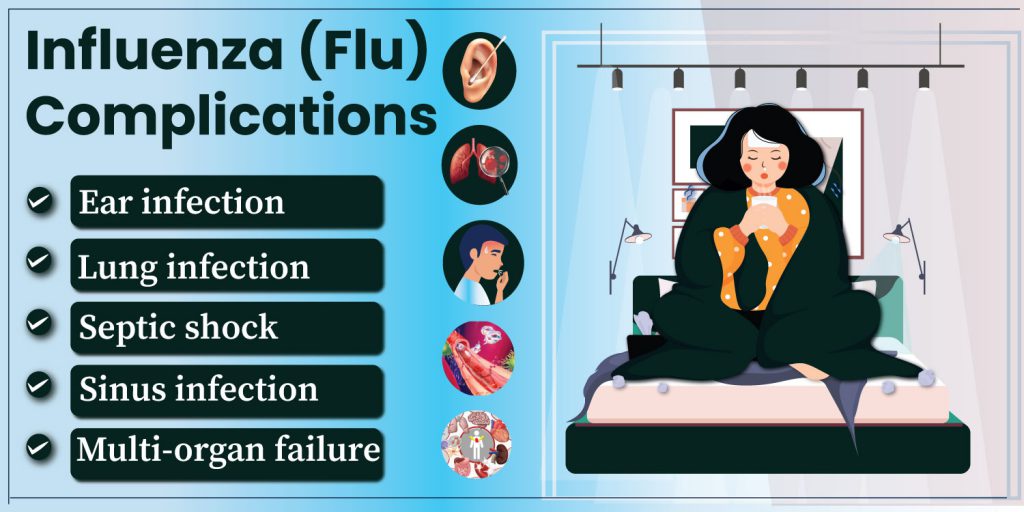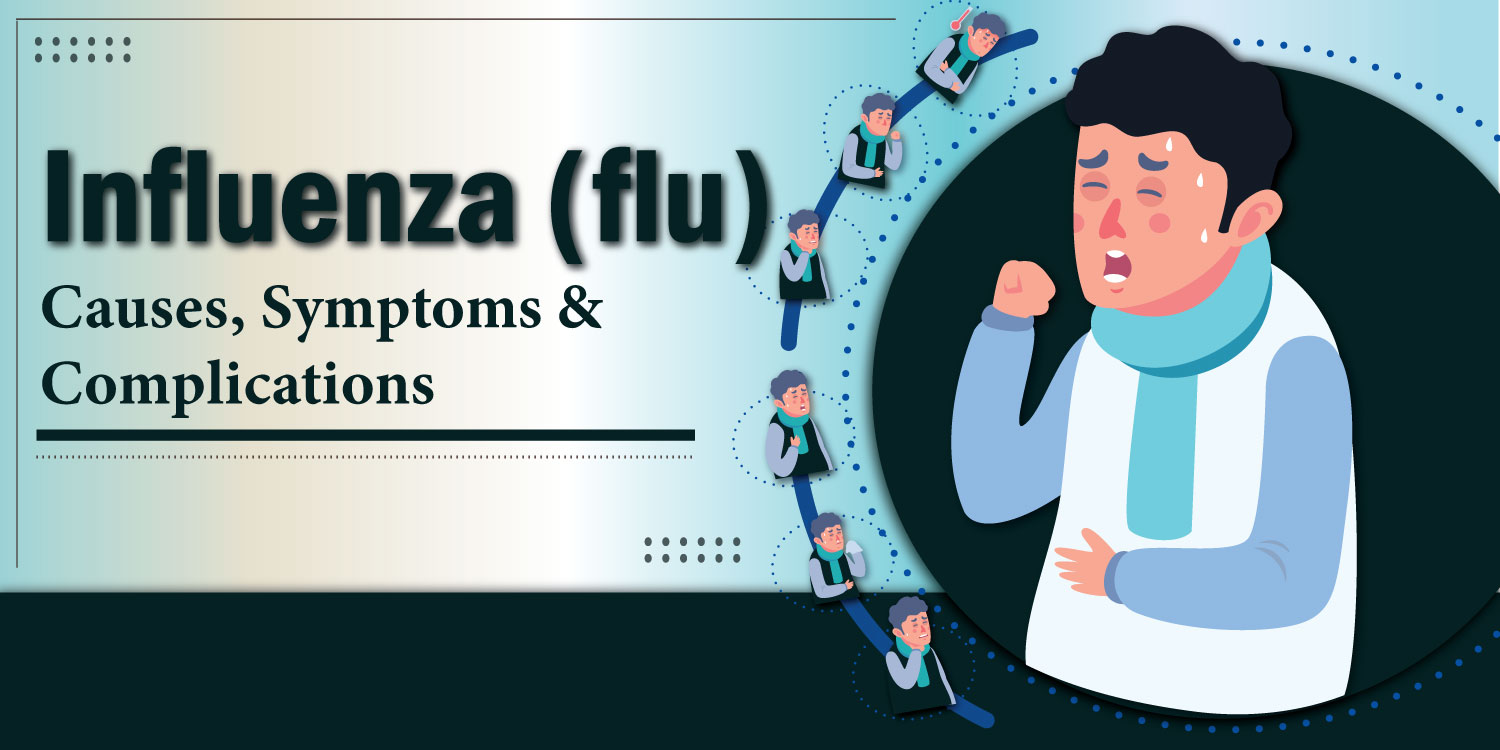Influenza (flu) – Causes, Symptoms & Complications
Because of Influenza (flu) Approximately 16 million people died in World War I. In 1918, a worldwide influenza epidemic(Spanish flu) killed an estimated 50 million people. Â While the Spanish flu is no longer active today, Â similar influenza viruses are still active. According to the World Health Organization, 1 billion individuals acquire the common flu each year.
Between 2010 and 2020, the Centers for Disease Control and Prevention (CDC) estimates that flu caused 9 million to 41 million illnesses, 140,000 to 710,000 hospitalizations, and 12,000 to 52,000 deaths.
In this blog, we discuss the key causes, symptoms, and risks of influenza flu.
Influenza (Flu) Causes
Influenza, or flu, is a common respiratory illness that is highly contagious. It is normally spread by the coughs and sneezes of an infected person.
Influenza viruses spread when people with flu cough, sneeze, or talk, sending droplets with the virus into the air and potentially into the mouths or noses of people who are nearby.
Influenza is easily spread from one infected individual to another, especially among those with impaired immune defenses.
Influenza Vs Covid-19
COVID-19 is an infectious disease caused by the SARS-CoV-2 virus. The first case of Covid-19 was recorded in Wuhan, China, in December 2019. There are several types of SARS-CoV-2, each with its own severity and transmissibility. Influenza is caused by the influenza virus, which is found in birds and other animals including pigs.
Both COVID-19 and the flu have similar symptoms, although the two infections are caused by distinct viruses.
According to the CDC, WHO, and NCBI:
â— COVID-19 is about twice as contagious as flu
â— The flu has a 2% hospitalization rate compared to COVID-19’s 19%;
â—Â Â Â Â The flu has a 0.1 percent case-fatality rate compared to COVID-19’s 1-3.4 percent;
Types of Influenza Virus
Based on their core proteins, influenza viruses are divided into three types: A, B, and C. The types most responsible for seasonal flu are types A and B. New influenza virus strains emerge and circulate every year. High mutation rates and frequent genetic reassortments are typical to type A and type B influenza viruses.
â— The most frequent is influenza A, which is also the cause of pandemic flu. It infects birds, bats, pigs, and a variety of other animals, including horses and marine mammals, in addition to humans.
â— Influenza B is mostly seen in humans, but it has also been found in seals, horses, dogs, and pigs. It exhibits symptoms that are similar to influenza A, but it is not known to trigger pandemics.
Type A Vs Type B Influenza
Type-A influenza is the most common cause of illness during flu season. It is also more harmful because the flu symptoms are generally more severe than those of type B influenza. Most adults have a lower level of immunity to type-A influenza.
Is it Flu or Cold?
The flu is an unpleasant but short-term illness that most healthy people will recover from easily. Influenza Symptoms often appear one to four days after virus exposure and last for five to seven days.
Although the flu might be unpleasant, it is rarely fatal.
It’s common to confuse the flu with a bad cold. A runny nose, sore throat, and cough are common flu and cold symptoms.
It’s critical to distinguish between flu and cold symptoms. The flu is a more severe respiratory ailment than a cold. While cold symptoms may last a few days, flu symptoms might last weeks. The flu can lead to major health issues like pneumonia.
To help you distinguish between the two, here are some cold and flu symptoms:
Cold Symptoms
When you contract an influenza virus, the first symptom is typically a sore throat that lasts for 2-3 days. On the fourth day, you will start experiencing nasal symptoms, runny nose, and congestion. While adults may recover following a few days of discomfort, children may experience fever as well.
Cold symptoms last around a week on average. You are contagious for the first three days after developing cold symptoms. This means you can spread the cold to others, so stay at home and rest up.
If your cold symptoms do not improve within a week, you may have a bacterial infection that requires antibiotic treatment.
Common Flu Symptoms
Flu symptoms are usually more severe and emerge sooner than cold symptoms. Sore throat, fever, headache, muscle aches, and cough are all flu symptoms. Vomiting and diarrhea are other common symptoms.
Most flu symptoms go away in two to five days, though you may feel tired for a week or longer. Pneumonia is a common flu complication, especially in children, the elderly, and people who have lung or heart problems. Consult a doctor if your fever returns after being gone for a day or two.
Early Symptoms of Flu
One of the first signs of the flu or a cold is fatigue. The fatigue that comes with the seasonal flu is usually more acute. Other early influenza symptoms include :
â— high temperature
â— cold sweats and shivers
â— headache
â— aching joints and limbs
â— fatigue, feeling exhausted
How can you know if you have the Flu or a Cold?
Many experts recommend taking your temperature. Flu symptoms, such as nasal congestion, cough, aches, and tiredness, are frequently misdiagnosed as cold symptoms. A common cold, on the other hand, rarely results in a temperature of more than 101 degrees. When you experience flu symptoms, you will most likely have a fever and feel uncomfortable or tired. Additionally, you may also experience mild to severe muscle pain and aches.
Influenza (Flu) Complications
For most people, the influenza flu causes a few days of discomfort. Flu complications, on the other hand, can be fatal in some cases. Hospitalization is usually needed for serious influenza complications.

Flu complications can include:
â— Lung infection
â— Septic shock
â— Multi-organ failure
â— Inflammation of the heart
â— Ear infection
â— Sinus infection
â— Worsening of long-term medical conditions, such as asthma, and diabetes
A person’s risk of getting serious complications from flu depends on several factors. The primary among these include:
â— Age: Adults aged 65 or more are at higher risks
â— Children: Children under the age of two can develop pneumonia after a flu
â— Asthma: Flu can cause further inflammation of the airways and lungs
â— Neurologic disorders: If you suffer from Neuropathic pain getting the flu can make your symptoms worse.
â— Blood disorders (such as sickle cell disease): Flu is more dangerous for people with anemia or other blood (hematologic) diseases.
Should you get a Flu Shot?
A healthy immune system can eliminate the virus and leave no evidence of it in the body. Most people who catch the flu recover in under two weeks. However, with age, the immune system’s response to type A and type B influenza virus weaken.
That’s why it is very important to take approved and certified flu shots!
Influenza Flu vaccines are available for everyone every season. Most people should be vaccinated for influenza each year. Vaccination is especially crucial for those who are at a higher risk of serious influenza complications.
However, depending on their age, present, and previous health, and whether they have particular allergies, certain persons should not be vaccinated or should not receive certain types of influenza flu vaccines. Here’s a complete list of Who Should & Who Should NOT Get Vaccinated
The Bottomline
Since the Spanish Flu epidemic of 1918, the world has been plagued by flu outbreaks. Each year, influenza kills between 290,000 and 650,000 individuals, with the very young and old being the most vulnerable. Vaccines are the most efficient way to stop influenza flu from spreading. Antiviral drugs are only effective for a few days at most. They serve just as a backup defense.
For the elderly, the very young, and others with compromised immune systems, respiratory infections that accompany flu can be lethal. As a result, the most vulnerable people must have access to high-quality healthcare. Kayawell brings high-quality healthcare to people’s smartphones. Fill out this form and connect with local health specialists right now.



